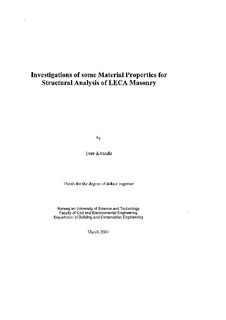| dc.contributor.author | Kvande, Tore | nb_NO |
| dc.date.accessioned | 2014-12-19T11:24:49Z | |
| dc.date.available | 2014-12-19T11:24:49Z | |
| dc.date.created | 2001-03-26 | nb_NO |
| dc.date.issued | 2001 | nb_NO |
| dc.identifier | 125214 | nb_NO |
| dc.identifier.isbn | 82-7984-170-9 | nb_NO |
| dc.identifier.uri | http://hdl.handle.net/11250/231228 | |
| dc.description.abstract | Masonry made from Light Expanded Clay Aggregate (LECA) concrete blocks is by far the most popular manufactured masonry in Norway. LECA is a lightweight aggregate (LWA).
The main objective of this study is to expand the knowledge about the material properties of LECA masonry to enable more accurate structural analysis and design of such masonry. The thesis comprises largely of experimental studies on the material behaviour of LECA masonry. Due to the relatively limited knowledge on the material properties of LECA masonry compared to that of concrete, a wide range of properties of LECA masonry has been studied in this thesis.
Because restrained shrinkage cracking is a major cause of damage to LECA masonry, mapping the behaviour of masonry with obstructed shrinkage is selected as an example. To be able to determine the deformation process of restrained LECA masonry, an identification of material properties of particular interest has been carried out. The identification was based on a restrained shrinkage cracking example. A summary of the material properties studied in this thesis work is given in Table 1. For comparison, design values of Eurocode 6 are also included in Table 1.
By determining a relatively wide range of important material properties, this thesis study has been largely instrumental in expanding the knowledge about the material behaviour of LECA masonry. While also the composition and the properties of the raw materials of the LECA blocks are documented, the study may form an important basis for further structural analysis of performance and further development of such masonry.
Even though a restrain shrinkage example was taken as a basis for the identification of interesting material properties, the experimentally obtained properties is relevant also for application of other structural problems. The validity of the properties is, however, limited to the LECA block quality of “3/770” only.
In order to pave the way for finite element analysis and design of LECA masonry structures, experimental determination of relevant material/model parameters were carried out in this thesis study. A micro-modelling can be restricted to account for the quasi-brittle material behaviour of the LECA and the average in-situ properties of the applied mortar. By applying generic material models in DIANA, the current test of LECA masonry subjected to uniaxial tension and compression/shear, this approach gave satisfactory results (see Høiseth and Kvande (2000) and Høiseth (2000b)).
Although the average stiffness and strength of mortal is usually somewhat higher than for the LECA units, a macro-modelling based on the LECA block properties should in general give sufficiently accurate results in global analysis of real structures. It must however be emphasised that the open perpend joint of LECA masonry makes the compound behaviour highly anisotropic. This anomaly represents discontinuity planes, which may be accounted for by interface elements representing predefined discrete cracks. | nb_NO |
| dc.language | eng | nb_NO |
| dc.publisher | Fakultet for ingeniørvitenskap og teknologi | nb_NO |
| dc.relation.ispartofseries | Dr. ingeniøravhandling, 0809-103X; 2001:9 | nb_NO |
| dc.subject | Construction engineering | en_GB |
| dc.subject | TECHNOLOGY: Civil engineering and architecture: Building engineering | en_GB |
| dc.title | Investigations of some material properties for structural analysis of LECA masonry | nb_NO |
| dc.type | Doctoral thesis | nb_NO |
| dc.source.pagenumber | 252 | nb_NO |
| dc.contributor.department | Norges teknisk-naturvitenskapelige universitet, Fakultet for ingeniørvitenskap og teknologi | nb_NO |
| dc.description.degree | dr.ing. | nb_NO |
| dc.description.degree | dr.ing. | en_GB |
